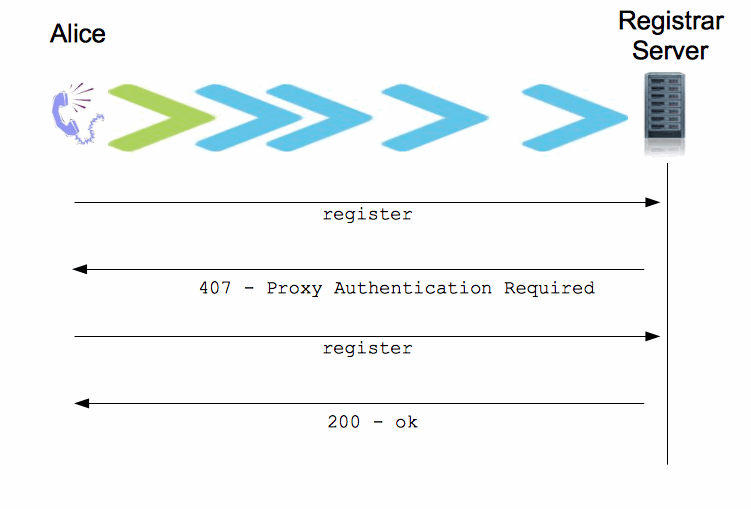Real Case: Asterisk receive an external call
A call from an external number to our pbx using a SIP trunk.
Att: I have “sniffed” that traffic using tcpdump.
tcpdump -i <interface> -s 65535 -w <file name>
In the next the Asterisk pbx is inside a LAN network, and its ip address is 10.10.10.110. The router in the network is configured with a public ip address 79.14.212.52. Asterisk is configured correctly using local network & public network parameters: in this mode all the message in SIP will be correctly valuated.
File sip.conf
[general] externip = 79.14.212.52 localnet=10.10.10.0/255.255.255.0
>>Message from ISTP provider (IP 212.97.59.76) to Pbx (ip: 10.10.10.110)
INVITE sip:5224851@79.14.212.52 SIP/2.0 Record-Route: <sip:212.97.59.76:5061;lr=on;ftag=as16df4853;rpp=np> Via: SIP/2.0/UDP 212.97.59.76:5061;branch=z9hG4bKc7f1.f1fb7516.1 Via: SIP/2.0/UDP 212.97.59.85:5060;branch=z9hG4bK683ee34f;rport=5060 From: "+393461050897" <sip:+393461050897@sip.messagenet.it>;tag=as16df4853 To: <sip:01042064023@212.97.59.76:5061> Contact: <sip:+393461050897@212.97.59.85> Call-ID: 509017dd3847bf900f839d877abfd752@sip.messagenet.it CSeq: 102 INVITE User-Agent: foxtrot Max-Forwards: 69 Date: Tue, 29 Nov 2011 00:29:39 GMT Allow: INVITE, ACK, CANCEL, OPTIONS, BYE, REFER, SUBSCRIBE, NOTIFY, INFO Supported: replaces Content-Type: application/sdp Content-Length: 356 v=0 o=root 21598 21598 IN IP4 193.227.104.40 s=session c=IN IP4 193.227.104.40 t=0 0 m=audio 35936 RTP/AVP 18 3 97 8 0 101 a=rtpmap:18 G729/8000 a=fmtp:18 annexb=no a=rtpmap:3 GSM/8000 a=rtpmap:97 iLBC/8000 a=fmtp:97 mode=30 a=rtpmap:8 PCMA/8000 a=rtpmap:0 PCMU/8000 a=rtpmap:101 telephone-event/8000 a=fmtp:101 0-16 a=ptime:20 a=sendrecv
The trace show an incoming call from number +393461050897 to our number (trunk with ITSP) that is 01042064023.
Att.: 5224851 is another internal number assigned from ITSP to the trunk that is linked to 01042064023: very commonly the ITSP use this “internal number” for REGISTER & OPTIONS messages.
Att.: The ITSP know where is located the our pbx because Asterisk send periodically a REGISTER & OPTIONS messages: the NAT is “opened” by this kind of messages.
The ITSP wants to receive the voice streaming to 193.227.104.40 port 35936.
Att: Very interesting the UA that receive the voice stream is different from the UA that establish the call (different ip address): it is very common using big ITSP.
>> Messages from PBX (ip 10.10.10.110) to ISTP provider (IP 212.97.59.76).
SIP/2.0 100 Trying Via: SIP/2.0/UDP 212.97.59.76:5061;branch=z9hG4bKc7f1.f1fb7516.1;received=212.97.59.76 Via: SIP/2.0/UDP 212.97.59.85:5060;branch=z9hG4bK683ee34f;rport=5060 Record-Route: <sip:212.97.59.76:5061;lr=on;ftag=as16df4853;rpp=np> From: "+393461050897" <sip:+393461050897@sip.messagenet.it>;tag=as16df4853 To: <sip:01042064023@212.97.59.76:5061> Call-ID: 509017dd3847bf900f839d877abfd752@sip.messagenet.it CSeq: 102 INVITE User-Agent: FPBX-2.8.1(1.4.40) Allow: INVITE, ACK, CANCEL, OPTIONS, BYE, REFER, SUBSCRIBE, NOTIFY, INFO Supported: replaces Contact: <sip:5224851@79.14.212.52> Content-Length: 0
>> Messages from PBX (ip 10.10.10.110) to ISTP provider (IP 212.97.59.76).
SIP/2.0 200 OK Via: SIP/2.0/UDP 212.97.59.76:5061;branch=z9hG4bKc7f1.f1fb7516.1;received=212.97.59.76 Via: SIP/2.0/UDP 212.97.59.85:5060;branch=z9hG4bK683ee34f;rport=5060 Record-Route: <sip:212.97.59.76:5061;lr=on;ftag=as16df4853;rpp=np> From: "+393461050897" <sip:+393461050897@sip.messagenet.it>;tag=as16df4853 To: <sip:01042064023@212.97.59.76:5061>;tag=as5dfb4137 Call-ID: 509017dd3847bf900f839d877abfd752@sip.messagenet.it CSeq: 102 INVITE User-Agent: FPBX-2.8.1(1.4.40) Allow: INVITE, ACK, CANCEL, OPTIONS, BYE, REFER, SUBSCRIBE, NOTIFY, INFO Supported: replaces Contact: <sip:5224851@79.14.212.52> Content-Type: application/sdp Content-Length: 238 v=0 o=root 2754 2754 IN IP4 79.14.212.52 s=session c=IN IP4 79.14.212.52 t=0 0 m=audio 18480 RTP/AVP 8 101 a=rtpmap:8 PCMA/8000 a=rtpmap:101 telephone-event/8000 a=fmtp:101 0-16 a=silenceSupp:off - - - - a=ptime:20 a=sendrecv
>>Final ACK
ACK sip:5224851@79.14.212.52 SIP/2.0 Record-Route: <sip:212.97.59.76:5061;lr=on;ftag=as16df4853> Via: SIP/2.0/UDP 212.97.59.76:5061;branch=0 Via: SIP/2.0/UDP 212.97.59.85:5060;branch=z9hG4bK0bbcf9cd;rport=5060 From: "+393461050897" <sip:+393461050897@sip.messagenet.it>;tag=as16df4853 To: <sip:01042064023@212.97.59.76:5061>;tag=as5dfb4137 Contact: <sip:+393461050897@212.97.59.85> Call-ID: 509017dd3847bf900f839d877abfd752@sip.messagenet.it CSeq: 102 ACK User-Agent: foxtrot Max-Forwards: 69 Content-Length: 0
Asterisk accepts the call and declare that want to receive voice stream to 79.14.212.52 port 18480.
Now start the voice streaming: in this figure this traffic “sniffed” and showed using wireshark.
PBX → ITSP
10.10.10.110 – src port 1840 → 193.227.104.40 dst port 35936
ITSP → PBX
193.227.104.40 src port 35936 → 10.10.10.110 – dst port 1840
We can see that Asterisk start to send packet: in this mode the NAT open the port correctly and the ITSP can reach the Asterisk PBX inside the LAN.
Another very interesting things is that tha ITSP UA use a different Ip Address for the SIP messages and for the RTP stream.
Antother Real Case: Interconnection Asterisk<->Avaya/Nortel BCM 450
In this case an external connected to an Avaya Pbx BCM450 call using SIP an Asterisk PBX.
Asterisk PBX – IP 10.10.10.110
Avaya PBX – IP 10.10.10.155
Extent connected to Avaya PBX that establish the call – IP 10.10.10.87
>> From Avaya to Asterisk
INVITE sip:420;phone-context=subscriber.private@10.10.10.110:5060;transport=udp;user=phone SIP/2.0 From: <sip:anonymous@anonymous.invalid>;tag=34e03fa8-a0a0a9b-13c4-55013-59a-5708f3a4-59a To: <sip:420;phone-context=subscriber.private@10.10.10.110;user=phone> Call-ID: 35036840-a0a0a9b-13c4-55013-59a-3609da9e-59a CSeq: 1 INVITE Via: SIP/2.0/UDP 10.10.10.155:5060;branch=z9hG4bK-59a-15e419-1faa1b5d Max-Forwards: 70 Supported: sipvc,x-nortel-sipvc,100rel,replaces User-Agent: Nortel Networks BCM VoIP Gateway release_46 version_46.46.0.33 P-Asserted-Identity: <sip:anonymous@10.10.10.155> Privacy: id;user x-nt-corr-id: 35036840-a0a0a9b-13c4-55013-59a-3609da9e-59a Contact: <sip:anonymous@anonymous.invalid:5060;maddr=10.10.10.155;transport=udp> Allow: INVITE,INFO,ACK,OPTIONS,CANCEL,BYE,NOTIFY,PRACK,UPDATE,REFER Content-Type: application/sdp Content-Length: 334 v=0 o=- 1323100317 1323100317 IN IP4 10.10.10.155 s=- c=IN IP4 10.10.10.87 t=0 0 a=sqn:0 a=cdsc:1 image udptl t38 m=audio 51000 RTP/AVP 18 4 0 8 120 111 c=IN IP4 10.10.10.87 a=fmtp:18 annexb=yes a=fmtp:4 annexa=yes a=rtpmap:120 telephone-event/8000 a=fmtp:120 0-15 a=rtpmap:111 X-nt-inforeq/8000 a=ptime:30 a=sendrecv
Asterisk -> Avaya
SIP/2.0 100 Trying Via: SIP/2.0/UDP 10.10.10.155:5060;branch=z9hG4bK-59a-15e419-1faa1b5d;received=10.10.10.155 From: <sip:anonymous@anonymous.invalid>;tag=34e03fa8-a0a0a9b-13c4-55013-59a-5708f3a4-59a To: <sip:420;phone-context=subscriber.private@10.10.10.110;user=phone> Call-ID: 35036840-a0a0a9b-13c4-55013-59a-3609da9e-59a CSeq: 1 INVITE User-Agent: FPBX-2.8.1(1.4.40) Allow: INVITE, ACK, CANCEL, OPTIONS, BYE, REFER, SUBSCRIBE, NOTIFY, INFO Supported: replaces Contact: <sip:420@10.10.10.110> Content-Length: 0
From Asterisk to Avaya
SIP/2.0 200 OK Via: SIP/2.0/UDP 10.10.10.155:5060;branch=z9hG4bK-59a-15e419-1faa1b5d;received=10.10.10.155 From: <sip:anonymous@anonymous.invalid>;tag=34e03fa8-a0a0a9b-13c4-55013-59a-5708f3a4-59a To: <sip:420;phone-context=subscriber.private@10.10.10.110;user=phone>;tag=as5b7d8e50 Call-ID: 35036840-a0a0a9b-13c4-55013-59a-3609da9e-59a CSeq: 1 INVITE User-Agent: FPBX-2.8.1(1.4.40) Allow: INVITE, ACK, CANCEL, OPTIONS, BYE, REFER, SUBSCRIBE, NOTIFY, INFO Supported: replaces Contact: <sip:420@10.10.10.110> Content-Type: application/sdp Content-Length: 206 v=0 o=root 2756 2756 IN IP4 10.10.10.110 s=session c=IN IP4 10.10.10.110 t=0 0 m=audio 16316 RTP/AVP 0 8 a=rtpmap:0 PCMU/8000 a=rtpmap:8 PCMA/8000 a=silenceSupp:off - - - - a=ptime:20 a=sendrecv
It is possible to verify with this Sip packet that the BCM 450 does not behave like a B2BUA: the asterisk pbx & extent of Avaya/Nortel BCM 450 connect itself each other directly !
PREVIOUS POST: From Sip to RTP (Part 5) – Trunks & surroundings
Linkografia
http://www.ietf.org/rfc/rfc3325.txt
http://en.wikipedia.org/wiki/Session_Initiation_Protocol







